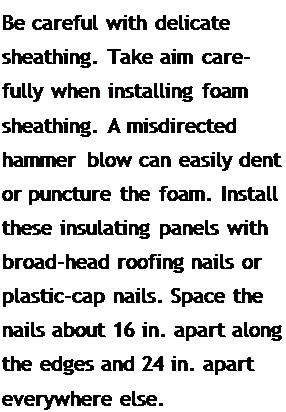Materials MORE SIDING OPTIONS
IN ADDITION TO VINYL SIDING, there are three more exterior finisies to consider if you’re interested in affordability, low maintenance, and attractive appearance:
Composite wood. These planks are made the same way as OSB sheathing panels, but they look like solid-wood clapboards or horizontal lap siding when installed. This siding comes with a factory-applied primer coat, and it needs to be painted after installation. Composite-wood planks don’t split, crack, or warp like solid-wood siding does, but they may not be a wise choice in extremely wet climates.
Stucco. Two tyaes of stucco finishes can be applied to house exteriors. Lightweight acrylic-type stucco treatments are available for application over specially prepared foam insulation board. And old – fashioned Portland cement-based stucco can be applied to masonry walls and to wire lath that’s been fastened to wall sheathing or directly to studs. It’s best to hire experienced professional crews to do these treatments. In hot, sunny cli
mates, stucco stands up better than most other siding treatments.
Tl-11. This plywood paneling can serve as both sheathing and finish siding, so it can be a real money saver. Tl-11 typically comes in 4×8 sheets and is available in different thicknesses. The "good" side of the panel has a rough-sawn wood finish that is divided lengthwise by a series of parallel grooves. A house sided with Tl-11 has a rustic appearance.
The panels are installed just like regular sheathing is—эу nailing through the plywood into the studs and plates. Be sure to use galvanized nails. The long edge of each panel is milled to meet in a lap joint. Tl-11 needs the protection of a good exterior paint or stain for the sake of appearance and longevity. Although it’s not a good long-term (20 years or more) siding, it enables you to cut down on construction costs and provides a workable base for subsequent siding treatments. Vinyl siding, fiber-cement siding, clapboards, and shingles can all be applied right over Tl-11.


range from T in. to 8 in.; there’s even a wide» single-board siding panel with a decorative bead along the bottom edge. Manufacturers offer most of their siding with either a smooth surface or a textured, wood-grain finish.
When choosing a siding color, hear in mind that it will fade slightly over time. Also, darker siding will absorb more heat and expand more than light-colored vinyl.
To estimate how much siding vou’ll need, refer to the sidebar on p. 150. Keep in mind that when vou buy vinvl siding, vou’re act nail v buying a comprehensive system of siding components: siding panels, J-channel, inside
and outside corner pieces, and other types of trim designed to simplify the installation and enhance the appearance. Siding manufacturers also make compatible vinyl soffit paneling and other components, such as vents, electrical outlet covers, and special exterior trim. It’s smart to get an overview of the full range of compatible products before you order siding. Go online to visit manufacturers Web sites or call to request product information (see Resources on p. 278).






Leave a reply